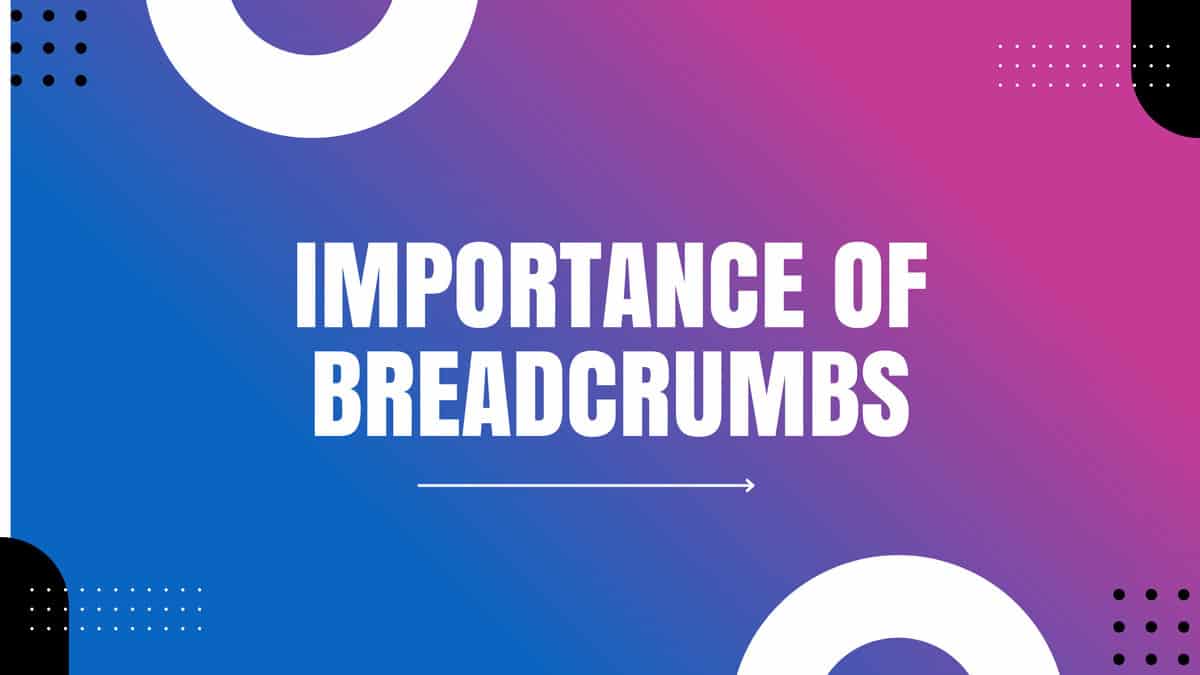Implementing breadcrumbs on your website can have a significant impact on both your user experience and SEO rankings.
In this guide, we’ll walk you through the importance of breadcrumbs and provide you with the best practices for implementing them effectively.
Breadcrumbs are a navigation aid that allows users to track their path back to the homepage on your website, making it easier for them to navigate between different pages and categories.
From an SEO perspective, breadcrumbs can improve your site’s structure, internal linking, and keyword relevance.
For more in-depth best practices, check out the following breadcrumb SEO best practices:
Key Takeaways:
- Breadcrumbs offer clear navigation: Breadcrumbs provide a visual hierarchy for users, making it easier for them to understand their current location within a website.
- Breadcrumbs improve user experience: By providing easy access to previous pages, breadcrumbs can significantly enhance the user experience and reduce bounce rates.
- Breadcrumbs can boost SEO: Search engines consider breadcrumbs as an additional way to understand the context of a page, which can improve the website’s overall SEO performance.
- Best practices for implementing breadcrumbs: Using a clear and concise structure, placing breadcrumbs near the top of the page, and ensuring they are responsive are essential for effective implementation.
- Keep breadcrumbs consistent: It is crucial to maintain a consistent breadcrumb trail across all pages of the website to avoid confusion among users and search engines.
- Use schema markup for breadcrumbs: Implementing schema markup for breadcrumbs can further enhance SEO by providing search engines with structured data about the website’s navigation.
- Test and iterate: Regularly testing and analyzing the performance of breadcrumbs can help identify areas for improvement and ensure they continue to serve their purpose effectively.

Table of Contents
Types of Breadcrumbs
Any website can benefit from implementing breadcrumbs to enhance user experience and improve SEO.
There are different types of breadcrumbs that you can use on your website to help users navigate your site more effectively and improve the visibility of your pages on search engines.
| Type of Breadcrumb | Description |
|---|---|
| Location-based Breadcrumbs | Show the user’s current location within the site. |
| Attribute-based Breadcrumbs | Display the attributes or filters applied to the content. |
| Path-based Breadcrumbs | Illustrate the path the user has taken to arrive at the current page. |
| Hierarchy-based Breadcrumbs | Show the user’s position in the site’s hierarchy and assist in navigating back to previous pages. |
It is essential to choose the right type of breadcrumbs that best fit the structure and content of your website to maximize its benefits.
Location-based Breadcrumbs
Location-based breadcrumbs show the user’s current location within the site.
They provide a clear pathway for users to retrace their steps within the site and help them understand where they are in relation to other pages.
Attribute-based Breadcrumbs
Attribute-based breadcrumbs display the attributes or filters applied to the content.
This type of breadcrumb helps users understand the specific details or characteristics of the content they are viewing.
Path-based Breadcrumbs
Path-based breadcrumbs illustrate the path the user has taken to arrive at the current page.
They provide a historical trail of the user’s navigation, allowing them to backtrack through their site journey.
Step-by-step Guide for Implementing Breadcrumbs
However, implementing breadcrumbs on your website requires careful planning and execution.
Here is a step-by-step guide to help you implement breadcrumbs effectively and improve user experience and SEO.
| Step | Description |
| 1 | Identify the hierarchy of your website and determine the most important categories and subcategories. |
| 2 | Decide on the breadcrumb types (location-based, attribute-based, or path-based) that best suit your website’s structure and content. |
| 3 | Use schema markup to provide search engines with structured data about the breadcrumbs on your website. |
| 4 | Implement the breadcrumbs design that complements your website’s overall look and feel, ensuring they are easy to locate and use. |
Factors to Consider Before Implementation
Before implementing breadcrumbs on your website, there are several important factors to consider.
Knowing and understanding these factors will help you make informed decisions that align with your website’s goals and user needs.
- The depth of your website’s hierarchy and the complexity of its structure
- The types of content and the nature of your website’s categories and subcategories
- The impact of implementing breadcrumbs on user experience and SEO
- The consistency of breadcrumb navigation across different devices and screen sizes
Tips on Planning and Designing Breadcrumbs
Planning and designing breadcrumbs requires careful consideration to ensure they offer value to users and search engines.
This will help you create breadcrumbs that enhance user experience and contribute to your website’s SEO efforts.
- Ensure your breadcrumbs are clear and concise to provide easy navigation for users
- Use keywords in your breadcrumbs to improve SEO and help users understand the context of the page they are on
- Test the visibility and usability of your breadcrumbs on different devices and screen sizes
Simple Process to Implement Breadcrumbs on Website
Implementing breadcrumbs on your website can be a straightforward process once you have planned and designed them effectively.
You can follow these simple steps to implement breadcrumbs on your website:
1. Choose the appropriate breadcrumb type based on your website’s structure
2. Select a user-friendly plugin or coding method to generate and display breadcrumbs
3. Test the breadcrumbs to ensure they are functional and provide a valuable navigational aid
Pros and Cons of Breadcrumbs
After implementing breadcrumbs on your website, it’s crucial to understand the advantages and disadvantages they can bring to your user experience and SEO. Here’s a breakdown of the pros and cons:
| Pros | Cons |
| Provides easy navigation for users | Potential for cluttering the user interface |
| Improves user experience and usability | May not be suitable for all types of websites |
| Boosts SEO by enhancing site structure | Requires regular maintenance for accuracy |
| Reduces bounce rates and increases time spent on site | Can add extra complexity to the website structure |
| Helps search engines understand the hierarchy of your site | Potential for keyword stuffing if not implemented carefully |
| Indicates the user’s location within the site | May not be effective for small websites with shallow hierarchies |
| Encourages users to explore more content on your site | Can impact the visual design of the website |
Benefits of Using Breadcrumbs in User Experience and SEO
Implementing breadcrumbs provide several benefits for both user experience and SEO.
Firstly, it offers easy navigation for your visitors, allowing them to understand the structure of your website and easily backtrack to previous pages.
Additionally, breadcrumbs improve the overall user experience by providing clear pathways for users to navigate your site.
From an SEO perspective, using breadcrumbs enhances site structure and helps search engines understand the hierarchy of your site, ultimately leading to improved search ranking and visibility.
Possible Drawbacks and How to Mitigate Them
While breadcrumbs offer several benefits, there are also potential drawbacks that you need to be aware of.
One key consideration is that breadcrumbs have the potential to clutter the user interface and add extra complexity to the website structure, so it’s important to carefully consider the design and placement of breadcrumbs on your site.
Additionally, you should regularly maintain and update your breadcrumbs to ensure accuracy and relevance. When used thoughtfully, these potential drawbacks can be mitigated, allowing you to fully leverage the benefits of breadcrumbs.
Best Practices for Implementing Breadcrumbs
Your website’s breadcrumbs should be implemented following these best practices to ensure a positive user experience and to boost your SEO efforts.
Tips for Optimal Breadcrumb Placement
When it comes to placing your breadcrumbs, position them prominently on your page, usually near the top, where they are easily visible without interfering with the overall design.
Use a horizontal placement for breadcrumbs, as this format is the most widely recognized and understood by users.
Make sure the breadcrumb trail is clickable, allowing users to navigate to previous pages with ease.
Knowing these tips will help improve the usability of your breadcrumbs and provide a better user experience.
Factors to Consider for Breadcrumb Design
When designing your breadcrumbs, it’s essential to consider the length of the breadcrumb trail, ensuring it doesn’t become too long and overwhelming.
Use clear and concise text to represent each level of the hierarchy.
Assume that users might start their journey from any page, and ensure that your breadcrumb trail accommodates this.
By paying attention to these factors, you can create an effective breadcrumb design that aids navigation and improves user experience.
Conclusion
Hence, implementing breadcrumbs in your website can greatly improve both user experience and SEO.
By providing clear navigation and hierarchical structure for your users, you can help them easily find their way around your website and improve their overall experience.
Additionally, breadcrumbs also help search engines understand the structure of your website and improve the indexing and ranking of your pages.
FAQ
Q: What is the role of breadcrumbs in user experience and SEO?
A: Breadcrumbs play a significant role in user experience by providing an easy navigation path for users to track their location within a website. From an SEO perspective, breadcrumbs help search engines understand the structure of a website and improve site indexing.
Q: What are the best practices for implementing breadcrumbs?
A: The best practices for implementing breadcrumbs include using a clear and consistent hierarchy, utilizing schema markup for search engines to understand the breadcrumbs, and ensuring that breadcrumbs are visible and accessible on all pages of the website.
Q: How do breadcrumbs improve user experience?
A: Breadcrumbs improve user experience by providing a clear trail for users to follow, allowing them to easily navigate back to previous pages or higher-level categories without having to use the browser’s back button.
Q: How do breadcrumbs contribute to SEO?
A: Breadcrumbs contribute to SEO by providing search engines with a clear understanding of the website’s structure and the relationship between content. This can lead to improved site indexing and potentially higher search engine rankings.
Q: Should breadcrumbs be included on every page of a website?
A: Yes, breadcrumbs should ideally be included on every page of a website to provide consistent navigation for users and to ensure that search engines can easily crawl and index the website’s structure.
Q: Are there different types of breadcrumbs that can be used?
A: Yes, there are different types of breadcrumbs, including location-based breadcrumbs (showing the user’s current location within the website hierarchy), attribute-based breadcrumbs (showing the path the user took to reach a specific page), and history-based breadcrumbs (showing the user’s recently visited pages).
Q: Can breadcrumbs be customized to match the website’s design?
A: Yes, breadcrumbs can be customized to match the website’s design by using CSS to style the breadcrumbs to fit seamlessly within the overall look and feel of the website. It’s important to maintain visibility and ease of use while customizing breadcrumbs.




